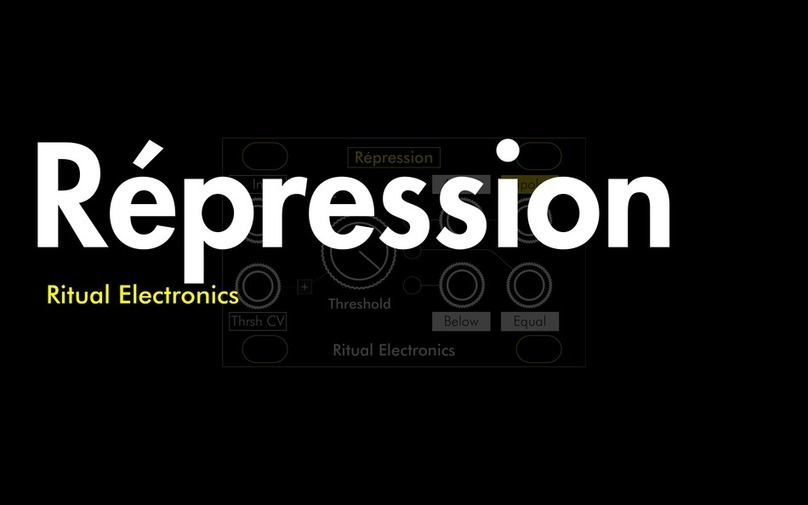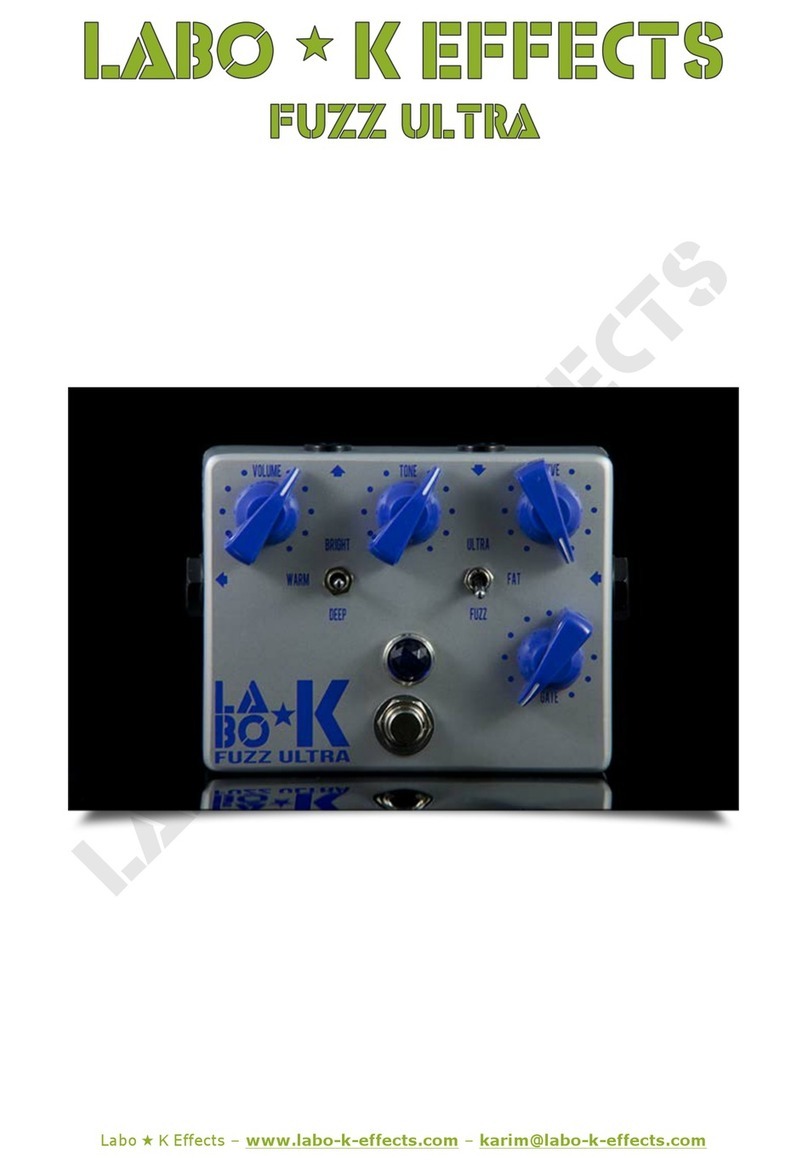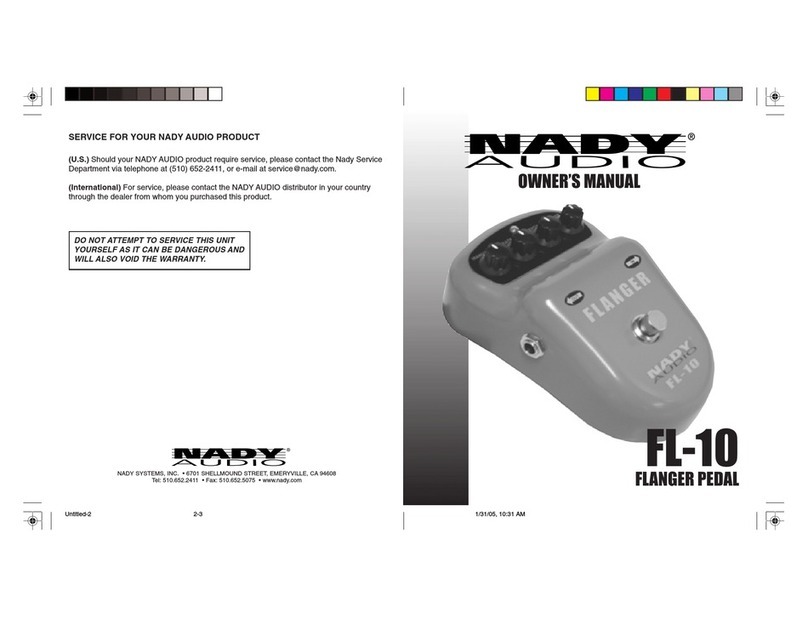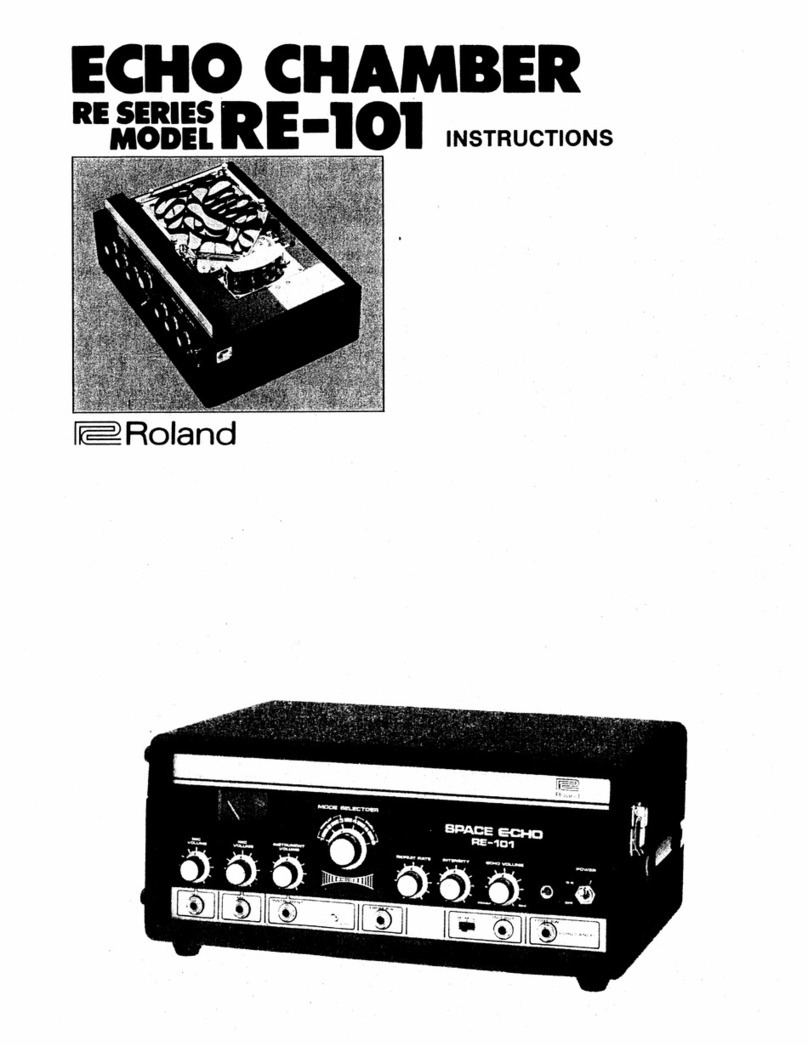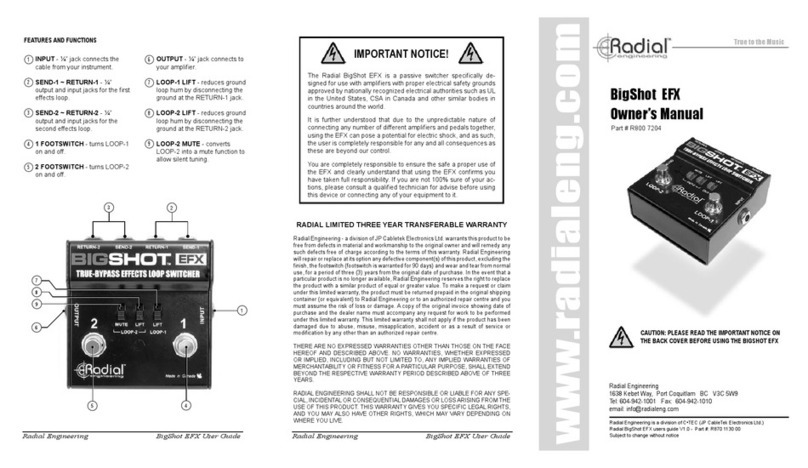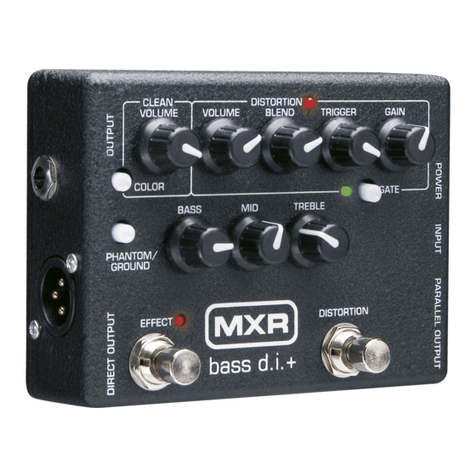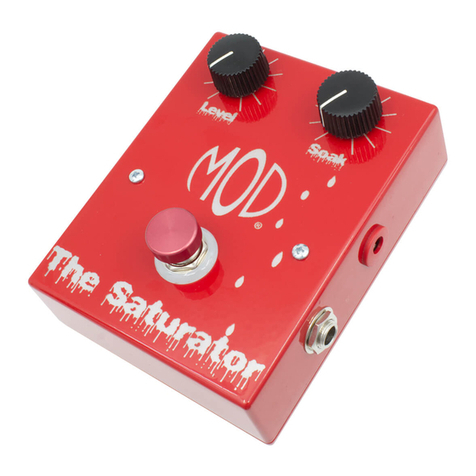Ritual Electronics Miasma User manual

Ritual Electronics
Miasma
Ritual Electronics
Feedback
Blend
_
Gain
Fdbk CV
Level
Gain CV In
+
_+
Fdbk In Fdbk Out
Miasma

2Summary
03................Warranty
04................Installation
05................Overview
06................Controls
07.................Block diagram
08................Diodes
09................Remarks
10.................Patch ideas

3Miasma
Thank you for purchasing Ritual Electronics Miasma.
Your module has been handbuilt with care in Paris, France.
You can find your module on Modulargrid:
https://www.modulargrid.net/e/other-unknown-miasma--
For any remarks and informations, contact us at:
contact@ritualelectronics.com
For video demos and patch ideas check:
https://www.instagram.com/ritualelectronics/
Limited warranty
Ritual Electronics warrants this product to be free of defects in materials
or construction for a period of one year from the date of purchase.
Malfunction resulting from wrong power supply voltages, backwards
or reversed eurorack bus board cable connection, abuse of the product
or any other causes determined by Ritual Electronics to be the fault of the
user are not covered by this warranty, and normal service rates will apply.
During the warranty period, any defective products will be repaired
or replaced, at the option of Ritual Electronics, on a return-to-Ritual
Electronics basis with the customer paying the transit cost to Ritual
Electronics. The return of your module is on us.
Ritual Electronics implies and accepts no responsibility for harm to person
or apparatus caused through operation of this product.

4Installation
Always turn your eurorack case off before plugging
or unplugging a module.
Do not touch any electrical terminals when attaching any Eurorack
bus board cable.
Ritual Electronics Miasma requires 35mA of +12VDC and 30 mA
of -12VDC regulated voltages and a properly formatted
distribution receptacle to operate. It must be properly installed into
a Eurorack format modular synthesizer system case. You can refer
to https://www.modulargrid.net/ to plan the power consumption
of your system.
You will need 10HP of free space in your Eurorack case to install
Miasma. Connect the included ribbon cable to the module,
the connector’s red strip must face down. Connect the other
end of the cable to the bus board connector of your case.

5Overview
Miasma is a voltage controlled distortion with a feedback
loop you can push to self oscillation for insane results and
interchangeable rectification diodes, giving you an unlimited
amount of sound possibilities within one module.
Miasma’s feedback path feeds the distorted signal back in the
input with no phase inversion, causing the module to self oscillate,
even with no input. The feedback path can be opened to send
it through different effects making Miasma perfect for complex
feedback patches.
A blend knob allows Miasma to be use in a precise way, for more
complex sound design.
The module’s clipping diodes are mounted on a header making
it easy to change them and craft the sound you want.
There module ships with six different diodes, from germanium
to LEDs and you can experiment adding your own. The output
level may vary depending on which diodes you use, this can
be adjusted with the level trimmer on the front panel.
Controls
• Gain control up to +20dB
• Feedback VCA
• Blend control between dry and wet signal
• Attenuverters on Gain and Feedback CV
• Level trimmer to adjust the output volume
Technical characteristics
• OTA based VCAs for gain and feedback control
• Feedback output jack is normalized to the feedback input jack
• One rectification diode per waveform polarity, for symmetrical or asymmetrical distortion
• Diodes can be swapped in and out without the need of tools
Electrical characteristics
• 35 mA +12V
• 30 mA -12V
• 0 mA 5V
Dimensions
• 37 mm deep
• 10HP large
• 3U

6
Feedback knob
Set the initial amount of distorted signal
feeding back into the distortion circuit
Gain knob
Set the initial amount of gain applied to
the input signal
Blend knob
Fully counter clockwise is the dry signal
Fully clockwise is 100% wet
Level trimmer
Set the output volume - it doesn’t affect
the overall distortion effect
Audio input
100k impedance - the input signal voltage
greatly influences the effect
Audio output
1k impedance
Gain attenuverter
Set the amount of CV applied to the gain
parameter. CW adds up to the gain knob
position, CCW substracts
Feedback attenuverter
Set the amount of CV applied to
the feedback parameter.
Gain CV input
CV input (-5/+5V)
Feedback CV input
CV input (-5/+5V)
Feedback loop input
Feedback input is normalized to the
feedback output jack. A jack breaks
the loop
Feedback loop output
Outputs the feedback signal - nothing
is present if there is no feedback
Miasma controls
Ritual Electronics
Feedback
Blend
_
Gain
Fdbk CV
Level
Gain CV In
+
_+
Fdbk In Fdbk Out
Miasma

7Miasma block diagram
Input Output
Feedback Out
Feedback In
Gain CV
Fdbk CV
Gain VCA
Injects the audio into
the distortion gain cell
Gain cell
Uses one diode
per waveform polarity.
Gain up to +40dB
Output buffer
1k impedence output
Feedback VCA
Controls the amount
of signal positively
reinjected in the gain cell
Blend
Crossfades from the original
signal to the distorted one

8Diodes
Miasma uses two diodes to rectify the signal. These diodes
define the colour of the sound. By making these diodes
interchangeable you can achieve a great palette of sounds.
The diodes create a different shape of distortion. There is one
diode per waveform polarity, to achieve asymetrical distortion.
The diodes influence both the distortion sound and the feedback
texture and pitch. See the waveforms on the adjacents illustrations.
Different diodes have different current and voltage consumption,
this can yield to volume increase or decrease from a configuration
to an other.
Miasma is shipped with 6 different type of diodes:
• 1N4148
• 1N914
• BAT42
• 1N60
• Blue LED
• Red LED
You can of course try your own!
Follow the instructions and only put diodes in the header.
Anything else put in the diode header will void your
warranty.
Diodes mount
Always disconnect Miasma from the power supply before changing the diodes!
The female header on which the diodes are mounted is located on the back PCB board
of Miasma. You can access the header without disassembling the module. Though the use
of twizzers is recommended if you don’t take the back board appart from the top one.
fig. I & fig. II
These are both valid ways to mount the diodes if you want to rectify both sides of the waveform
fig. III
By using only one diode, you’ll create asymetrical distortion and rectify only one side of the
waveform (it is recommended to do so with the germanium diode which sucks a lot of sound and
prevents feedback when combined with another type of diode)
fig. I fig. II fig. III

9Remarks
A distortion is a waveshaping effect, it is best used with
simple frequencies with little frequency content. A sine
wave, a triangle wave or a filtered sound will be more
affected by Miasma.
The input level affects the overall sound of the distortion. Try
running your signal in an amplifier or attenuator to increase
Miasma’s sound possibilities.
When the gain increases the feedback decreases. When the
gain is pushed to the max you may not hear any feedback,
the two parameters are related.
Different diodes lead to different output levels. This can be
corrected using the “Level” trimmer on the front panel.

10Patch ideas
Ritual Electronics
Feedback
Coarse
Fine
Blend
_
Gain
Fdbk CV
Level
Gain CV In
+
_+
Fdbk In Fdbk Out
Out
Miasma
1V/Oct Lin FM
Exp FM PWM
Coarse
Fine
1V/Oct Lin FM
Exp FM PWM
Coarse
Fine
1V/Oct Lin FM
Exp FM PWM
Patch #1 - Audio rate modulations
The modulation buses in Miasma respond extremely well to audio
rate modulations. Try to modulate both the gain and the feedback
at audio rate to achieve great effects.
Adjacent frequencies will produce beating effect for really doomy
effects.
Tuned frequencies are kind off mixed together which can result in
chord-like effects.
Patch notes
Oscillator 1, sine wave out ------------ Miasma In
Oscillator 2, triangle wave out ------------ Gain CV
Oscillator 3, square wave out ------------ Feedback CV
Adjust the attenuverters for a deeper effect.
The output can be patched to a filter or other processing modules
for further sound design

11Patch ideas
Patch #2 - Tuned feedback
When a sound processing module is connected between the
Feedback Out and the Feedback In it is pushed into feedback. It
causes a filter to self oscillate in a special way. This way you can
tune Miasma’s feedback. It is particularely useful when used with a
drum sequence or a tuned synth line.
Patch notes
Oscillator, triangle wave out ------------ Miasma, audio in
Miasma, feedback out ------------ Filter, audio input
Filter, output ------------ Miasma, feedback in
Tune the filter according to your oscillator
Try to use the same 1V/Oct signal in the oscillator and in the filter FM,
this will harmonize both lines
Coarse
Fine
1V/Oct Lin FM
Exp FM PWM
Ritual Electronics
Feedback
Blend
_
Gain
Fdbk CV
Level
Gain CV In
+
_+
Fdbk In Fdbk Out
O
u
t
Miasma
FMRes Freq
In LP2
BP2
Gain LP4 VCA
L
P
4

12Patch ideas
Patch #3 - Doom Reverb
Inserting a reverb in the feedback path will result in pretty wild
feedback sounds. With the right settings it can sound like guitar
amp feedbacks.
Depending on your reverb, further processing may have to be
patched to achieve this sound.
Patch notes
Synth / Drum line ------------ Miasma, audio in
Miasma, feedback out ------------ Reverb, audio input
Reverb, output ------------ Miasma, feedback in
Envelope / LFO / random ------------- Miasma, feedback CV
Changing the reverb parameters will affect the sound
Play with the dry/wet parameter of your reverb
Ritual Electronics
Feedback
Blend
Blend
_
Gain
Fdbk CV
Level
Gain CV In
In
+
_+
Fdbk In Fdbk Out
O
u
t
O
u
t
Miasma
Tilt Decay
Absorb
Size Pre
D
ept
h
S
pee
d
Size
Speed Pre-delay Absorb
DepthT ilt Decay

13Patch ideas
Patch #4 - Drum smasher
Miasma is great at handling highly dynamic signals like drums.
Signals with lots of transient tend to cut through the feedback.
Try running a kick drum with feedback open, it will make the
feedback “pump”.
When processing a drum bus, or more complex signals, try using
a attenuator + pre-amp to adjust the input gain for more sound
design options.
Patch notes
Synth / Drum line ------------ Amp + Envelope follower, audio input
Amp + Envelope follower, audio output ------------ Miasma, audio input
Amp + Envelope follower, envelope output ------------ Miasma, feedback CV
Synth / Drum line, clock ------------ Clock divider, clock in
Clock divider, divided out ------------ Envelope generator, trig / gate in
Envelope generator, envelope output ------------- Miasma, gain CV
Ritual Electronics
Feedback
Attack Decay
Attack Decay
Attack Decay
Attack Decay
Blend
_
GainGain
Fdbk CV
Level
Gain CV In
In
/2
Rst
Trig
Env
/4
/8
/16
/32
/64
Gate
Out
+
_+
Fdbk In Fdbk Out
O
u
t
Miasma
Trig 1
Env 1
Trig 2
Env 2
Trig 3
Env 3
Trig 4
Env 4

14Patch ideas
Patch #5 - Harsh noise machine
Patching Miasma with a complex oscillator like some sort of
feedback harsh noise machine results in earthy distorted sounds.
Just tweak Miasma’s attenuverters and your oscillator FM setting
like a mad man for crazy synth noises.
Patch notes
Oscillator 1, waveform 1 ------------ Miasma, gain CV
Oscillator 2, waveform 1 ------------ Miasma, audio input
Oscillator 2, waveform 2 ------------ Miasma, feedback CV
Oscillator 2, final waveform ------------- Miasma, feedback in
Miasma, feedback out ------------- Oscillator 1, exponential FM
Ritual Electronics
Feedback
Frequency 1
FM BusExponential FM
Linear FM
Exponential FMM od Bus Folder
Shape
Angle
Linear FM
Frequency 2
Blend
_
Gain
Fdbk CV
Level
Gain CV In
+
_+
Fdbk In Fdbk Out
O
u
t
Miasma
Expo Index CV 1V/Oct Lin
E
xp
o
1V/Oct Folder CV
M
o
d
C
V
_+_+_+
_+
_+
Folded
Shape CV
Angle CV
Table of contents
Other Ritual Electronics Music Pedal manuals
